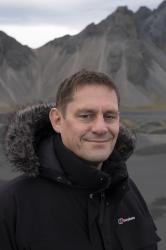Dance should be the most accessible, comfortable, familiar art form known to mankind. Everybody has a body, and most people can move theirs—even if only in part—making the ability to dance an almost universally shared experience.
And yet, dance as performance is often perceived as culturally ring-fenced; intended for those aficionados who “get it”, but not so much for the common folk.
The Reykjavík Dance Festival, which wrapped up the performances of its 19th year last month, is having none of that nonsense. Directors Brogan Davison and Pétur Ármannsson, the Anglo-Icelandic couple who took the reins of the festival only at the start of this year, are quietly determined to democratise dance.
“It’s something we really think about, and one of the problems that we face with this festival,” Brogan reflects after the event. “And one of our intentions this year was to make it more accessible.”

Petur and Brogan, with baby raver Írena – photo by John Pearson
The dance of the common folk
One way that the festival fosters that accessibility is to balance the virtuosity of professional festival performance with the dance of ordinary people. As Pétur observes: “How does my grandmother dance in the kitchen with my grandpa? How does our baby daughter dance to CoComelon on Netflix? It’s our responsibility to tap into this folky side of dance.”
Normally, folk are able to get dancey at the various parties which form the fabric of the festival around its performances—in “the spaces between”, as Brogan calls them. A COVID-19 rapid test regime for audiences saved this year’s scheduled performances. Unfortunately the same approach wasn’t possible for those more freewheeling interactive elements, and much of the action in the spaces between simply wasn’t possible.
However Brogan and Pétur did manage to save the festival’s Baby Rave, (literally a rave for babies—surely the ultimate in youth outreach), by following the format of recent times and streaming the event from their living room. Its success is one that they hope to bring to next year’s programme, along with more symposiums, workshops and artist talks to optimise access for audiences.

Rave, baby, rave! Photo by Owen Fiene.
Open and reflective
Accessibility is a theme clearly embedded in the DNA of the Reykjavík Dance Festival. One of the standout performances this year was ‘Stefnumót’, (Icelandic for ‘Rendezvous’), three pieces created by bringing together a performer with a disability and one without. Each resulting show was accompanied by a candid conversation between performers and audience about the creative process, its challenges and the insights revealed.
“I think it really embodied the festival,” Pétur reflects. “It was diverse, it was subversive, it was surprising, it was funny. And it was accessible for everyone else. So we’re really proud of that event.”
As well as being accessible, dance should naturally reflect the social and political issues touching those who create and experience it. As Pétur observes: “Good art is of this world. I think that to connect with people it needs to be somehow in the same space as them.” Such connections were made this year through performances like ‘Dance If You Want To Enter My Country’, in which Michikazu Matsune reflects on racism and the nature of identity. And ‘When The Bleeding Stops’—a piece by Lovísa Ósk Gunnarsdóttir focusing on the silence and sense of taboo surrounding menopause—was a hot ticket, clearly connecting with a community touched by that theme.

When the Bleeding Stops. Photo by Owen Fiene.
Making connections
Outreach is a large part of the festival’s purpose. It is active in the community all year round, and is probably best thought of as an arts foundation that holds biannual events. Thanks to a commitment of long-term support by the City Of Reykjavík, the festival is able to lead programmes engaging underserved social groups. One such initiative is the Litla Systir project, an evening “school” which encourages creative activity and critical thought in teenagers and offers participants an active role in helping curate events.
So the festival’s mission might be described as bringing dance to the people. However Brogan understands that those new to dance might fear that they won’t understand the culture. “If people are coming in and maybe seeing dance for the first time, they might worry that they won’t understand the ‘rules’ of the space,” she observes. But with an interactive, innovative and experiential approach, Brogan and Pétur hope that these barriers can be dismantled. It’s all about getting dance to the people, and getting the people to dance.

Photo by Owen Fiene.
Buy subscriptions, t-shirts and more from our shop right here!


















